Dr Vino's wine blog
wine talk that goes down easy
St. Jean de la Gineste – a value vielles vignes carignan
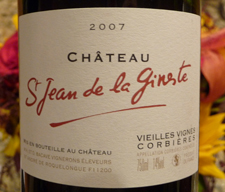 Carignan. When Bacchus was handing out the mellifluous names of grape varieties in French–Cabernet, Chardonnay, and Merlot roll easily of the anglophone tongue–he had apparently run out by the time he got to Carignan. In America it is often called carignane when planted, if at all, on domestic soil. But even in the Languedoc, in the south of France where the grape proliferates, reasonable people like Jancis Robinson have dumped on the grape for tasting like battery acid (or something).
Carignan. When Bacchus was handing out the mellifluous names of grape varieties in French–Cabernet, Chardonnay, and Merlot roll easily of the anglophone tongue–he had apparently run out by the time he got to Carignan. In America it is often called carignane when planted, if at all, on domestic soil. But even in the Languedoc, in the south of France where the grape proliferates, reasonable people like Jancis Robinson have dumped on the grape for tasting like battery acid (or something).
By contrast, Becky Wasserman told me she considers Carignan to be “the Pinot Noir of the south,” especially given its high natural acidity. Wasserman, an exporter of French wine, includes one Carignan in her portfolio and it is a value, particularly now as the weather turns chilly. The family-run St. Jean de la Gineste, in the Corbieres appellation, cultivates some old vines of Carignan, ferments the grapes in a neutral, concrete vessel, and blends in 15 percent grenache. I purchased the resulting 2007 wine at New York Vintners for about $14 and found this true taste of Carignan to be worthy of respect. Dark in the glass, the un-pinot-like 14% alcohol makes it a bigger wine but the rustic grape tannin is unadorned by oak and then there’s the good acidity. Now if only I could rustle up some cassoulet…
There’s Zin. And then there’s Ridge Geyserville. [mature wine]
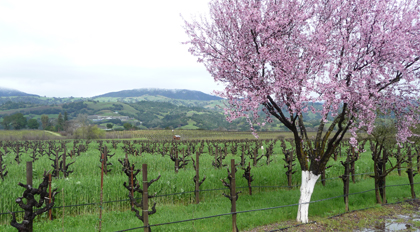
All too often, Zinfandel is a highway to a quick, cheap buzz. It’s often confused with white zin, rarely celebrated by wine writers aside from patriotic holidays, and it’s almost never aged.
However, there’s Zin, and then there’s a wine like Ridge Geyserville.
I had a chance to visit the property and talk with the cellar masters this past spring. Although I also tasted some spectacular wines of Monte Bello, I was looking forward to the tasting of old zinfandels dating back to 1973, including multiple pairs of Geyserville and Lytton Springs–could a Zinfandel age gracefully, I wondered? Read more…
Forget web 2.0 — some wineries need web 0.9 (plus some wine picks)
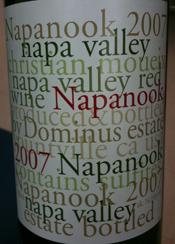 More Americans are drinking wine today than ever before. However, increasingly confident and interested wine consumers are thirsty not just for wine, but for reliable information about the wines they consume. Sadly, winery (and importer and trade association) websites don’t always provide the information we now crave. Forget social media and “web 2.0”–too many wineries haven’t even mastered web 0.9 yet.
More Americans are drinking wine today than ever before. However, increasingly confident and interested wine consumers are thirsty not just for wine, but for reliable information about the wines they consume. Sadly, winery (and importer and trade association) websites don’t always provide the information we now crave. Forget social media and “web 2.0”–too many wineries haven’t even mastered web 0.9 yet.
Consider the recent discussion about Corbieres that emerged following my post about a wine from the region last week. Readers debated the percentage limits for the grape Carignan in the wine. Since this is a statute of the AOC regulations, you’d think it would be on the AOC/syndicat web site. But it’s not.
Or consider the six wines I was putting together my NYU wine class for last night. I was looking for some basic information about the wine I was serving, the vineyards, the cellar masters, and a photo for the slide show. Here’s what I found: Read more…
Terroir de Whole Foods?
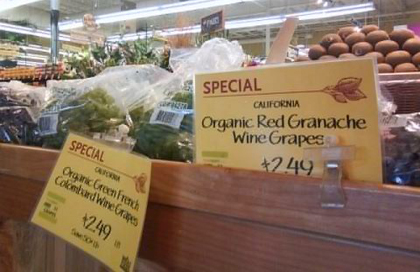
The Whole Foods Market in Winston-Salem, NC, sells wine grapes by the pound. $2.49 a pound for “Organic Red Granache (sic) Wine Grapes,” “Organic Green French Colombard Wine Grapes,” and “Organic Black Carignane Wine Grapes.” Taste the difference, pre-wine! Or maybe it is another DIY wine thing?
Even though the store sits on the edge of the fastest-growing wine region of the country, the grapes are from California.
Thanks, Mark, for the cameraphone pic!
The best box wines of 2008
“Merry Christmas!” I said to my aunt as she greeted us at the door for our annual wintry get together with my cousins. “Here’s 24 liters of wine!” Although I had told her that I would bring the wine, I hadn’t mentioned that it was eight three-liter boxes of wine. Season’s greetings!
So my relatives were the latest involuntary recruits in my effort to find the best box wines of 2008. You might think that the best box wine is kind of like being the tallest resident in Gulliver’s Lilliput. And you’d mostly be right. But since I called for more wine to be put in box format for economic and environmental reasons earlier this year, I thought that I owed it to you to do a quick survey of the landscape. I still think they make sense economically since they pack in the same amount as four regular bottles and mostly sell for around $20 (although the most expensive one I tried was $40).
What I like best about the packaging is the ability to squeeze off a glass a night for an extended period of time, thirty days or more according to the producers.
Standing tall
 1. Yellow + Blue Malbec, Mendoza, Argentina (about $11 for one liter; find this wine)
1. Yellow + Blue Malbec, Mendoza, Argentina (about $11 for one liter; find this wine)
This organically grown red from Argentina sees no oak, is shipped to North America in a tanker where it is packaged into a Tetra Pak–think juice boxes for adults. I’ve poured this wine, introduced for the first time in 2008, many times to groups this year, often blind and from a decanter, and it has been almost universally praised. And when I tell them it’s the equivalent of $8 a bottle, they usually wonder where they can get a case.
2. “From the tank,” Estezargues, 2007. Cotes du Rhone (about $40; find this wine)
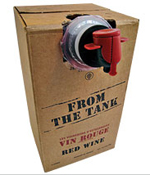 This big blend of grenache, syrah and carignan, has that ripe, juicy quality from many of the wines of the region. New to the US market this year, it’s organically grown and has a complexity that you really wouldn’t expect from a three liter, bag-in-box format. One word of caution: I found that this wine depreciated a week after opening so it may be best at parties, rather than nursing it over a whole month.
This big blend of grenache, syrah and carignan, has that ripe, juicy quality from many of the wines of the region. New to the US market this year, it’s organically grown and has a complexity that you really wouldn’t expect from a three liter, bag-in-box format. One word of caution: I found that this wine depreciated a week after opening so it may be best at parties, rather than nursing it over a whole month.
The best of Lilliput
Underdog Wine Merchants is a relatively new unit of The Wine Group, a boring sounding company that is actually the third largest producer of wine in America. They know a thing about box wine too since they make the dreaded Franzia, which has stigmatized the box format almost single handedly. But with Underdog, they are generally cranking quality up a notch, appealing to specific demographics with various brands, which can more often than not, seem to be trying a bit too hard with cutesy names or text on the packaging.
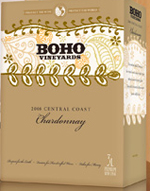 The best of their offerings, in my view, are the BOHO Cabernet Sauvignon and Chardonnay (about $20 for 3L; find this wine). You won’t mistake the Cab for a St. Estephe in a blind tasting but it seems to have something approaching on structure, without excessive flab that many super-low-priced Cali Cabs have from oak chips. The Chardonnay is also restrained in it’s oak effect, a good thing in my view.
The best of their offerings, in my view, are the BOHO Cabernet Sauvignon and Chardonnay (about $20 for 3L; find this wine). You won’t mistake the Cab for a St. Estephe in a blind tasting but it seems to have something approaching on structure, without excessive flab that many super-low-priced Cali Cabs have from oak chips. The Chardonnay is also restrained in it’s oak effect, a good thing in my view.
Honorable mention
Darling Hills, Ovation, South Africa (about $20 for 3L; find this wine): a 50-50 blend of Cabernet Sauvignon and Cinsault, the workhorse grape originally from the South of France. It has a smoky note–think chipotle–that some that I served this absolutely adored, others hated. One thing’s for certain: the wine changed for the worst after only a couple of weeks of being open, so drink up.
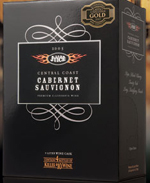 Killer Juice (about $20 for 3L; find this wine): Another wine from Underdog, this wine is packaged with a Harley aesthetic and the dramatic proclamations about the “killer” quality. While I found it a little two brawny and low in acidity, it was a favorite at my aunt’s house as my cousins kept squeezing off pours from this one. A crowd pleaser.
Killer Juice (about $20 for 3L; find this wine): Another wine from Underdog, this wine is packaged with a Harley aesthetic and the dramatic proclamations about the “killer” quality. While I found it a little two brawny and low in acidity, it was a favorite at my aunt’s house as my cousins kept squeezing off pours from this one. A crowd pleaser.
I look forward to reviewing box wines again in 2009. Three liter box wines have been a strong growth segment for the past few years and consumer attitude, as least on this site, are ready. So I’m raising a glass in the hope that more producers will continue to see better wines in this format.
Jenny & Francois drink inside the box!
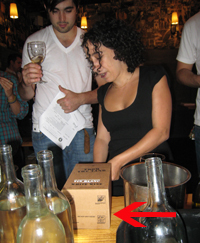 Faster than you could say “Holy carbon footprint, Batman!” two new box wines have arrived on our shores!
Faster than you could say “Holy carbon footprint, Batman!” two new box wines have arrived on our shores!
Naturalista wine importers Jenny and Francois win the prize for the first new box wine since my op-ed in the NYTimes last month! Actually, the red was around last vintage but the white is all new! Double your pleasure while reducing your carbon footprint.
Both the wines are from the Cotes du Rhone cooperative Estezargues, which Jenny & Francois claim is the only co-op in France to make “natural” wines (no commercial yeasts, no enzymes, no filtering, minimal sulfur before bottling).
The white, called “From the Tank” and packaged in unbleached cardboard, is actually a great value transitional white for fall (find this wine). This 2007 is aromatically complex, its big and rich, with typical low acidity, and dry. I was envisioning pairing it with a squash risotto. Although it is not a low-priced box wine at $40, it is, they write in their catalog, “exactly the same wine as what we bring in bottles,” which sell for about $14.50 each. Booyah! For all the Wine Century Club members out there, its 70% Grenache Blanc, 20% Clairette + Bourboulenc, and 10% Viognier.
The red, a big blend of grenache, syrah and carignan, has that ripe, juicy quality from many of the wines of the region. The wine lacked the precision and structure of some their other Rhone reds but it is a solid offering to keep around for squeezing off a mid-week glass. It’s the same price as the white “From the Tank.” (find this wine)
I didn’t have time to taste through all their wines at their trade tasting last week, unfortunately. But I did like the Binner wines from Alsace, which I had not previously discovered (search for Binner). The pillowy pinot gris 2006 has no added sulfites; the 2006 gewurztraminer had a blast of white flowers and mango on the aroma and balanced tropical fruits on the palate.
Green wine: the zen forest of Matassa, Roussillon

Perched in the hills and nestled in the forest not far from the sea lie the vineyards of Matassa. But the vigneron farming the land in Rousillon, on the French side of the Pyrenees, is distinctive for two reasons. First, he’s young. And, second, he’s from South Africa.
Tom Lubbe lives near the vineyards with his family. He developed Matassa with Nathalie Gauby and Sam Harrop, MW, who used to be the head buyer for Marks & Spencer. At a recent tasting where I tried their wines, Tom told me that the Rousillon is one of the few places in France where a young person can afford to start out since real estate in many other wine growing areas is horrendously expensive.
Tom has several vineyard parcels and he farms them all biodynamically, a sort of organic plus method. He aims to make the wines as naturally as possible and even do a preliminary foot crush and use only indigenous yeasts. The prized vineyard, in Tom’s eyes, is one of 112 year old carignan at 1,800 feet above sea level. It’s surrounded by a forest so Tom doesn’t have to worry about pesticides from a neighbor blowing into his vineyard.
The labels have two surprising things on them. First, simplicity. Many French labels are cluttered with confusing terms such as superieur when the wine is not actually all that superior. These labels have zen-like minimalism and in fact include a kanji character on them (the one for forest). Second, Harrop and Lubbe are some of the rare quality wine producers who have thumbed their nose at the appellation system and make only vin de pays wines, specifically vin de pays Cotes des Catalanes. There are no grape varieties on the labels, however, since vdp regs state that a wine has have a 100 percent truth claim to state the variety on the label.
 The Cuvee Marguerite is a blend of viognier and petit grain muscat aged in old Burgundy barrels. It has huge araomatic intensity and an intriguing minerality underneath. (find this wine)
The Cuvee Marguerite is a blend of viognier and petit grain muscat aged in old Burgundy barrels. It has huge araomatic intensity and an intriguing minerality underneath. (find this wine)
The Matassa blanc is a white of rare intensity from the region. Surprisingly pleasant acidity, the wine has a wonderful well-balanced and waxy texture with great minerality and hint of Key lime and a drop of honey. (find this wine)
Moving to the reds, the “Cuvee Romanissa” 2004 is a surprisingly light and lively blend of mostly grenache with a dollop of carignan, mourvedre, and cabernet sauvignon (find this wine). Dark fruits and an alluring savory character make this a great food wine, calling out for grilled meats. The piece de resistance is the Matassa rouge, made from all 112 year old carignan (find this wine). Surprisingly light in color in the glass, the wine has a sort of rusticity on the nose that compliments dark fruit notes. On the palate the wine has a light weight yet great intensity and balance between fruit, acid, minerality and lightly peppery tannins. Really an extremely attractive red wine. And to think it is from the humble carignan…
Environmentally friendly. Good packaging. Great product. Other French producers should take note and follow the lead of Matassa (it’s just a pity about the price, but hey, you can’t have it all).
Total production: 20,000 bottles. Importer: Eric Solomon.
Discussing rustic
 Rustic, is it good or bad for a wine?
Rustic, is it good or bad for a wine?
Charlie, a participant in my last NYU class, cited it as the reason for his taking the class. He said that a friend had served him some wine recently and described the wine as rustic. Charlie had to find out what that meant.
I heard the word again yesterday at a tasting of wines from the Alto Adige region of Italy. One producer described lagrein, a grape variety, as rustic. So what is “rustic”?
I think of rustic mostly as a good thing. When discussing good value wines, I think of it as off-the-beaten-path varieties or regions that maybe have some quirks or rough edges but also have a certain undeniable charm, particularly in the face of a pasteurized, homogenized wine in an “international” style. One importer used the term “rustic authenticity” to underscore this difference. For varieties I think of connonau, aglianico, falanghina, pinot d’aunis, carignane, or moschofilero. For regions I think of Fitou, Cahors, Basilicata, Sardinia, or the Halkidiki among others. Few of these wines are meant for cellaring–they’re meant to be enjoyed soon, with a good meal.
I suppose if the term were applied to high end wines, such as Burgundies, it would be interpreted as a bad thing or a flaw. But in the context of good value, everyday drinking wines, it’s something to seek out even if it does mix in some clunkers with the charm.
What are your favorite “rustic” wines? Can a new world wine be rustic?




